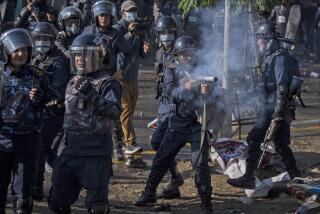China TV, in Rare Coverage, Shows Film of Tibet Riots
- Share via
BEIJING — China’s state-run television, in rare coverage of ethnic violence, showed film Sunday evening of an anti-Chinese riot Thursday in the Tibetan capital of Lhasa in which six people died.
The film showed hundreds of angry Tibetans throwing stones at police and setting vehicles on fire. It also showed a police substation that was attacked and burned by the crowd.
The official People’s Daily on Sunday published four pictures of the riot scene.
These, according to the captions, showed monks parading with a Tibetan “snow mountains and lions” flag and shouting “Tibet wants independence!” They also showed a burned-out police substation, an overview of the central Tibetan quarter of Lhasa with smoke billowing above the roof lines and several charred vehicles.
Eyewitness Account
Along with the photographs, the People’s Daily ran a graphic eyewitness account, filed from Lhasa by reporters of the official New China News Agency, of how the arrest of some of the original demonstrators touched off the riot:
“As the police officers on duty brought ringleaders to the police substation for inquiry, many people gathered around the house. A group of people began to throw stones at the doors and windows. They burst into the house, beat up the policemen and took away the ringleaders brought into the substation by the police.
“After they left the substation, they continued throwing stones and bricks, making it impossible for the more than 30 policemen to get out. This reporter saw a young man snatch away a machine gun from a policeman.
Attack at Substation
“The seven motor vehicles parked in front of the gate of the police substation also became the targets of their attack. They crushed the windows and doors of the vehicles, turned them over and set them on fire.
“The rioters continued to throw stones at the onlookers and the police who were trying to stop them. A few shots of gunfire were heard amid the confusion. A boy of about 4 or 5 was knocked down by a big piece of stone, his mouth bleeding. A Tibetan old woman was trembling with fear. With arms crossed, she prayed, facing the blazing building.
“At this time, six fire engines arrived. But no sooner had the firemen connected the hoses to the taps than a rain of stone was falling down on them. The windows of the two fire engines in front were all crushed to pieces and one fireman was hit by stones on the head, bleeding.
Knock on Doors
“Meanwhile, some rioters ran into small lanes, knocking at the doors of residents, shouting, ‘The Dalai Lama is making Tibet independent, and we all must follow!’ ”
The report charged that rioters threatened those who refused to join them, saying they would “have their houses smashed.” It also said that one rioter offered to pay children to throw stones.
Tibet, during its long history, has sometimes been independent and sometimes part of the Chinese Empire. It has been firmly controlled by China since 1951. The Dalai Lama, Tibet’s former theocratic ruler, fled to India in 1959 after an abortive uprising against Chinese rule.
The New China News Agency reported Saturday that six people died in the riot but that all the deaths were caused by rioters, not by police. That report said that police had not fired their weapons. The report, published in People’s Daily on Sunday, did not say how the people were killed.
Differing Account
Some foreign tourists returning from Lhasa to the central China city of Chengdu late last week, however, told wire service reporters that police had fired at the rioters and that at least three and probably about six Tibetans were killed.
Zhao Yunqiu, an official in the Lhasa Foreign Affairs Office, was quoted Sunday by the Associated Press as saying that all six fatal victims reported by the New China News Agency were policemen.
“We have regulations . . . not to shoot at demonstrators, so they just shoot their weapons . . . to the sky, not to the people,” Zhao said in English, according to the AP report. “Some of the people (Tibetans) have their own weapons. They cannot manage it so . . . (they) shoot the people, including police and including their own people.”
Monks at the Sera Monastery on the outskirts of Lhasa, in a taped discussion in English with French tourists that was later shared with the AP, acknowledged that some Tibetans had obtained weapons but denied that they fired them.
More to Read
Sign up for Essential California
The most important California stories and recommendations in your inbox every morning.
You may occasionally receive promotional content from the Los Angeles Times.













